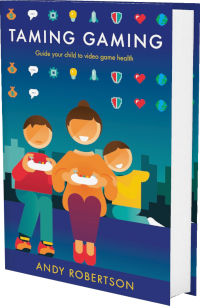 Android
Android iOS
iOS Mac
Mac Switch
Switch Wii
Wii Wii U
Wii U PC
PC PS4
PS4 PS5
PS5 Xbox One
Xbox One Xbox X|S
Xbox X|S27/07/2021 08:39:01 2 years ago Author: Andy Robertson
We are still working out what video games are, and how to talk about them. Unlike books or films, we don't yet have a very developed way of talking about the wide-ranging benefits and experiences that video games offer. Over the years I have used different metaphors to help uncover hidden aspects of video games.
The aim is to set aside the technological hurdles to reveal their humanity. The metaphors I use below – of games as cathedrals to explore, mountains to climb, paintings to lose yourself in, and so on – are my way of tempting parents and carers to give video games a try for themselves.
More Like Cathedrals Than Playing Fields
Viewed from a distance or at an angle from across the room, we only see the flickering flat surface of video games. Position yourself over your child’s shoulder or next to them, though, and they become a window to another place. Linger there for more than a few minutes and this view becomes a door through which the player enters another world that responds to their interactions.These virtual worlds are spaces where players can do things and be someone they can’t in their normal life. This might be the simple satisfaction of completing rows in Candy Crush, taking charge of pizza delivery in an ad-hoc restaurant team in Roblox’s Work at a Pizza Place, or exploring the weather-worn landscapes and day–night changing tundra in The Legend of Zelda: Breath of the Wild.
This may sound similar to how books and films offer windows into imaginary or historical worlds, but games don’t focus your view with directorial control of the camera, insist you listen to particular dialogue or progress at a certain pace. Instead, they invite you to step into the space they create.
This is more complex than the well-known rules of the flat playing field. The football pitch, rugby ground and tennis court are marked out for simple and well understood competitions. Playing a video game is more like walking into an ancient cathedral, pristine shopping mall, quiet library or noisy stadium. These spaces invite different interactions and use of imagination depending on the way they look, sound and feel.
And unlike playing fields (apart from games that simulate sports), the rules of video games aren’t always marked down or apparent; they can take time to understand. When we first enter a space like this it can be confusing, but over time, and by returning to it periodically, it can become a valued part of our lives.
Remembering this is helpful when we first encounter video games. Allowing ourselves to get a little lost, get it wrong, miss things or go the wrong way is a natural part of being somewhere new. It takes time to understand how these new spaces work, how other people behave in them and how we want to engage with this ourselves.
This sense of initial confusion and trial-and-error exploring is part of what players love about video games. As much as for the completing, solving or winning, games are enjoyed for the spaces they create. Worlds where the usual rules don’t apply.
For children, this is the chance to be heroes, regardless of playground hierarchy, or physical or psychological challenges. They can engage in social interactions at their own pace. They can escape worries or fears and establish the calm they need to think clearly while they play. For adults, games can be like stepping into a museum packed with cultural artefacts or a cathedral with stained-glass windows and soaring architecture. These spaces offer a chance to spend time somewhere that is designed for us to discover, participate in, and interpret for ourselves.
More Like Mountains Than Machines
On the face of it, video games are machines. Under the visual veneer, they are frantically responding to our tapping, pressing and pushing of screens, buttons and sticks. They’re working like the clappers to present us with a game world to enjoy.But they are strange machines. The printing press, the factory and the car are considered worthwhile for what they enable us to achieve or what they produce. Shortcomings and costs are balanced by the benefits of production. As a result, it’s tempting to see video games as a new way to achieve things. Gaming is sometimes justified for its entertainment, transferable hard skills or how it can incentivise players to behave in a certain way and learn things. But this mixes up the noise of the engine with the ability to travel somewhere.
The algorithms that drive video games – whether it’s the hero’s journey of Tearaway Unfolded, the jumping ascent of Celeste or the hunting in Horizon Zero Dawn – aren’t primarily designed to produce a tangible benefit or have a particular function. Video games aren’t designed to enable you to produce something. They are more like mountains, created to be climbed.
‘We think they are appliances, mere tools that exist to entertain or distract,’ writes Ian Bogost in his book How to Talk About Video Games. But, with their looming presence, ‘they insert themselves into our lives, weaving within and between our daily practices, both structuring and disrupting them. They induce feelings just as art or music or fiction might do.’
‘We play games because they are there to be played. Because we want to feel what it’s like to play them,’ continues Bogost. Like the challenge of climbing great snow-capped peaks or running a coast path, it’s hard work to play a game. There’s the discomfort of concentrating on something solely for its own sake; the commitment of taking time out of our busy lives to persevere with it; the irritation that the game is reluctant to submit to the plans we have for it.
We play video games such as Animal Crossing, Subnautica or Hollow Knight not for any particular benefit but because they are immovable, mountainous challenges. We climb them even though failure is likely. Even at their summit, there are endless other mountains to climb.
But as Jesper Juul puts it in The Art of Failure, ‘Failure connects us personally to the events in the game; it proves we matter, that the world does not simply continue regardless of our actions.’ Video games exist for us but at the same time are oblivious to what we need them to do.
For young players standing at the foothills of a new video game, there’s an invitation to climb further than they have gone before and commit to something bigger than they can imagine. For adults, video games offer an almost insurmountable challenge. They can be a place of reflection and deep thinking, provided we are willing to count the cost of the climb. Reaching the peak isn’t just about making it to the top, but what we had to find inside ourselves to get there.
More Like Paintings Than Films
Video games let us progress at our own pace. We control our path through their worlds with the movement of our character, how quickly we solve puzzles and which interactions we choose.In this way, although many games increasingly look like movies or animations, they are experienced more like paintings. It may sound strange to compare an endlessly moving, interactive space to finite brushstrokes, but whether we are playing Flower, Fe or Alan Wake, the encounter is strikingly similar when you experience it.
Gazing at a painting draws us in until nothing else exists in the room for us. Our eyes move over the canvas at our own pace, noticing some details while missing others. We explore the scene in seemingly random order. What we see mingles with memory and brings to mind all manner of other images. As Jeanette Winterson puts it, ‘There is a constant exchange of emotion between us … the artist I need never meet, the painting in its own right, and me, the one who loves it… The picture on my wall, art object and art process, is a living line of movement, a wave of colour that repercusses in my body’.
This is what games do. Like a painting, they create space to meditate and think deeply about what we are seeing. Whether it’s the lifelike tundra of The Witcher 3: Wild Hunt, the stylised darkness of Limbo or the children’s storybook pages of Florence, game worlds bring to mind other real-world places, people and times of life, so that the real and virtual intermingle in our mind.
In a game, though, the canvas moves and responds to our presence. There is an unexpected reversal as we become co-creators of the world we are exploring. It is as if the painting isn’t complete until we see it, and now that we do, it becomes visibly malleable and porous to our ideas. The experience is a combination of appreciating the brushstrokes that create the space while at the same time being granted the exhilarating permission to move the paint around.
For young players, like the fascinating and absorbing experience created by good galleries and museums, video games are a chance to see the world differently, with space and time to think deeply about what that means. For busy adults, their interactive worlds trick us into dropping our guard and lingering in their electronic brushstrokes.
More Like Poems Than Novels
Although some video games include a lot of dialogue and narration, playing them is more like reading poetry than novels. They intentionally break the rules of storytelling, just as poems break the rules of grammar.Rather than tell stories directly, or in an accepted order, we overhear narrative from passers-by, or deduce it from how the world responds to us. The way a button behaves in Firewatch, or how a puzzle is solved (or unsolvable) in Uncharted: Drake’s Fortune, offers as much of a story as the things characters say to us and to each other.
Like poems for our fingertips, we must feel our way forward with interactions. At times all we can do is continue headlong into confusion. We worry that we’ve missed crucial information or are unable to interpret what’s happening. Games like Hellblade: Senua’s Sacrifice or What Remains of Edith Finch don’t make things easy for us. Like a poem, they continue with impenetrable confidence regardless of whether we can keep up, insisting that everything will make sense by the end.
Both games and poetry can seem as though they’re not meant for us; poems aren’t for children, and games aren’t for adults. Only they are. Whether it’s age, class, literacy, culture or technology, there are hurdles to overcome before we can access either of these precious resources, but there are substantial benefits to people of all ages and from all backgrounds once we do.
There’s no easy way round this, apart from starting to read poems and play games. Discovering the pleasure of either can happen in a moment and last a lifetime. We can be minding our own business, when we pick up a controller and then, out of the blue, encounter something that changes our perspective forever. Video games like That Dragon, Cancer or Papers, Please come to us – as Jeanette Winterson describes the role of fiction in her book Art Objects: Essays on Ecstasy and Effrontery – with exhilarating force from outside our familiar experience, ‘clearing a space for new stories about ourselves’.
Games offer children a way into something they can’t fully understand or explain. For adults, video games offer unusual, experiential perspectives on familiar topics that get under the skin in unexpected ways.
More Like Theatre Than Films
Video games are often lauded for their life-like or artistic visuals. These draw comparisons to films with their realism and impressive effects. However, the experience of playing a video game is less like the linear unchanging journey through a film and more like the ever-changing and varying performance of live theatre.It's not until you revisit a game for the second time, much like going back to see theatre again, that the variations and nuance of a video game really emerge. Like theatre performances that have to cope with unexpected audience reaction, or staging not being perfect, video games are built to cope with inconsistent human players.
Each time you play through a game it's different because of the choices you make. This is true for games that are built to branch in accordance with how you play them. But it's also true for games that simply offer a world to explore. The order you move through them. The exact path you choose. How quickly you progress. All these things add up to make each play-through surprisingly different.
Like theatre, games arrant multiple visits. Unlike film, where repeat viewing may reveal noticed aspects, video games change in their rudimentary order, pacing and performance.
More Like Walks Than Races
Video games create participatory spaces where we spend time with virtual characters. Like family walks, their worlds and dramas are an excuse to talk, move and orienteer together. We set out with just the thought of adventure and discovery but return home with a greater connection to the people we’ve travelled with.Whether it’s the puzzles in Heaven’s Vault, coming-of-age drama Knights and Bikes or Affordable Space Adventure’s intrepid exploration, games invite our participation as friends, guardians, brothers, sisters, mothers, fathers, aunties and uncles (to name a few), rather than mandatory competitors. And, like walks, our interactive options are limited. Locomotion is predetermined, and our route can’t stray too far if we’re to get home again. We can do certain things and can’t do others. We linger at the back or rush on ahead. We fall into the steady rhythm of play and find ourselves talking and listening rather than racing.
In many ways, video games shouldn’t work. The heavy-handed narrative of Detroit: Become Human, awkward characters in The Legend of Zelda: Breath of the Wild, rudimentary anthropomorphic shapes in Thomas Was Alone, and inability of two characters to touch each other convincingly in Uncharted: Drake’s Fortune, should undermine any emotional quality game developers try to create.
But because these peculiar and uncanny visuals represent people we travel the virtual world with, they actually affect us deeply. Heading out the door to walk virtual streets with video game characters creates a connection with them (as well as the people we are playing with). Together we stand shoulder to shoulder in shoot-outs, hunt down missing artefacts, travel vast distances and even come close to death. So when they permanently die or admit to character flaws, it feels as though these things are happening to people we know. And in many ways they are.
Like those family walks, games create a calm space to learn about people and relationships without particularly worrying about where we are going or keeping up with others on the same outing. For children reluctant to put on wellies, such games are a chance to walk in someone else’s shoes. For adults, they take us to a new horizon with space to discover fresh perspectives when we get there.
© 2024 Family Gaming Database












